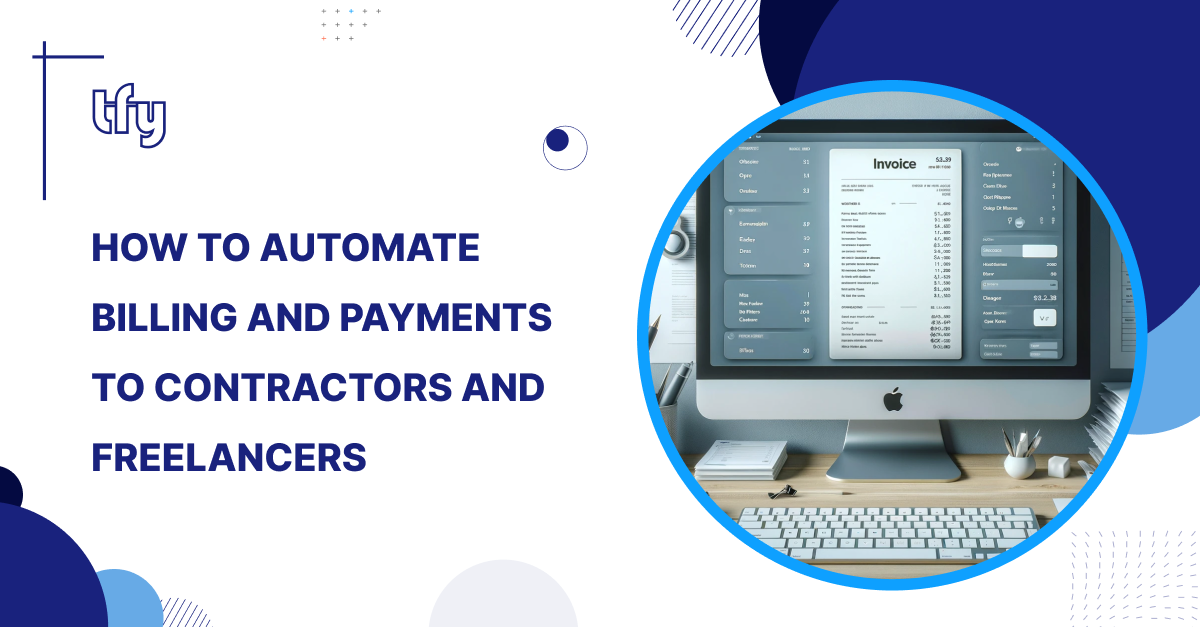
In recent years, the gig economy and freelance work have gained significant momentum, particularly during the recent COVID-19 pandemic. As per Upwork's Freelance Forward 2022 report, ‘’60 million Americans, about 39% of the total American workforce, did freelance work in 2022, contributing $1.35 trillion to the country's economy. This marked an increase of $50 billion compared to 2021. Additionally, as of May 2023, there were nearly 26 million part-time workers in the U.S., an increase of just under 500,000 compared to the prior year.’’
The rising trend towards part-time and freelance work is not just a result of changing job market dynamics but also a reflection of worker preferences. However, this shift brings with it several challenges, particularly when it comes to managing payments to contractors and freelancers. This guide provides an in-depth look at how businesses can automate billing and payments to contractors and freelancers, streamlining their operations and ensuring timely and accurate payments.
The Necessity of Automating Billing and Payments
According to a study, 39% of invoices are paid late in the United States. The urgency to automate billing and payments is driven by several factors. First and foremost, manual processes are fraught with errors. Whether it's a misplaced decimal point, an incorrect date, or a missing invoice, these mistakes can cause significant problems for both the business and the contractor.
Moreover, manual processes are time-consuming. Every invoice that needs to be created and every payment that needs to be processed takes away precious time that could be spent on core business activities.
Automating these processes not only eliminates the possibility of human error but also frees up time, allowing businesses to focus on what they do best - providing excellent products and services to their customers. This means that automation simplifies the process and brings cost efficiency and accuracy.
Understanding Payments to Contractors
Before discussing how to automate payments to international contractors and freelancers, it is crucial to understand what these payments entail. Payments to contractors are different from regular employee salaries. Contractors are typically paid per project or per hour rather than a fixed monthly salary. They are also responsible for their own taxes, benefits, and insurance.
As a result, the process of paying contractors requires additional steps compared to paying employees. The business needs to verify the work done, calculate the payment based on the agreed rate, issue an invoice, and then make the payment. This can be a cumbersome process, especially for businesses that work with multiple contractors.
Furthermore, contractors often work remotely or in different countries, which adds another layer of complexity to the payment process. Different countries have different tax laws and banking systems, and businesses need to navigate these differences to make payments to contractors.
The Challenges with Traditional Contractor Payment Methods
Traditional methods of contractor payment, such as checks and bank transfers, come with their share of challenges. Checks are slow, prone to getting lost, and require the contractor to physically deposit them in their bank account. On the other hand, bank transfers can be expensive due to high transaction fees, especially for international payments.
Moreover, these methods don't offer much visibility into the payment process. Businesses can't track the payment status, and contractors don't know when they will receive their money. This lack of transparency can lead to frustration and mistrust between businesses and contractors.
Another issue with traditional payment methods is that they aren't scalable. As a business grows and starts working with more contractors, the process of making payments becomes increasingly complex and time-consuming. This can hinder a business's ability to grow and
How to Automate Billing and Payments to Contractors and Freelancers?
Let’s explore how to automate billing and payments to contractors and freelancers, thereby streamlining the process and saving time and resources.
Creating Thousands of Payments to Contractors and Freelancers at Once Using Transformify
Transformify, a leading vendor management system, offers an efficient solution for businesses facing the challenge of managing hundreds or even thousands of payments to contractors and freelancers at once. The platform provides an API and a CSV file upload feature that allows businesses to create multiple payments in one go.
The Power of Self-Billing
One of the unique features offered by platforms like Transformify is self-billing. This eliminates the need for contractors and freelancers to have knowledge about accounting and taxation, thereby making the payment process easier for them.
What is Self-Billing?
In a self-billing arrangement, the customer (in this case, Transformify in its capacity of Agent of Record) generates the invoice on behalf of the supplier (the contractor or freelancer). This is typically done using the information provided by the supplier, such as their tax and VAT numbers, invoice details, and so on.
Self-billing can be particularly beneficial for businesses that work with many contractors or freelancers. It can help streamline the invoicing process, reduce paperwork, and ensure timely payments. Plus, it can also help businesses maintain better records of their payments, thereby aiding in compliance and reporting.
Transformify offers self-billing capabilities, automatically issuing self-billing invoices on behalf of the contractors and freelancers. All the contractors and freelancers need to do is provide their invoice details, tax number, and VAT number, if applicable.
Reconciliation of Payments and Invoices Made Easy
Transformify acts as an Agent of Record, stepping in between the businesses using the services of contractors and freelancers and the service providers. This means that businesses receive just one invoice for each batch of created payments, regardless of whether there are 10 or 1,000 payments included in the batch. This significantly simplifies the reconciliation of payments and invoices, saving businesses time and administrative effort.
Using Transformify's Payment Rails
For many businesses, integrating with payment providers and maintaining those integrations can be challenging. This is where Transformify's payment rails come into play.
Transformify takes care of all integrations with payment providers, and new integrations are added upon request. Businesses and freelancers can choose from various options such as PayPal, Venmo, Payoneer, Revolut, 20+ cryptocurrencies, SWIFT, SEPA, local ACH in the US, local bank transfers, and more.
By automating billing and payments to freelancers and contractors, businesses can save up to 60% on costs and ensure proper classification of contractors and freelancers in line with international labor legislation. Whether it's through the use of specialized contractor management software such as Transformify or the implementation of innovative solutions such as self-billing, automation offers a host of benefits that can help businesses navigate the complexities of the gig economy.
So why wait? Start automating your billing and payments to contractors and freelancers today and reap the benefits of efficiency, accuracy, and compliance.



